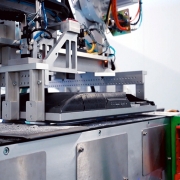Switzerland: Hitachi Zosen Inova Starts Green Hydrogen Production Facility
Hitachi Zosen Inova (HZI) and the Aarau-Lenzburg Regional Waste Disposal Association (Gemeindeverband für Kehrichtbeseitigung Region Aarau-Lenzburg or GEKAL) will produce hydrogen at the waste-to-energy plant in Buchs (canton of Aargau).
It is planned that the first hydrogen will be produced at the beginning of 2023. “Full operations will commence a few months later in the spring of 2023,” HZI announced in March. “The main off-taker of the hydrogen will be Messer Schweiz AG in Lenzburg.” That company specializes in the supply of industrial gases. The new plant “will represent a valuable, and above all, local source of green hydrogen, enhancing the circular dimension of the thermal recycling facility,” HZI commented.
The joint venture project will involve the Swiss-Japanese cleantech company constructing the first Waste to Hydrogen (WtH2) small-scale commercial plant, a press release said. HZI would take care of all planning and construction work for the facility at the GEKAL site, and will also be the owner and operator in the first few years. “The hydrogen produced will be used as technical gas for industry and early mobility applications, for example, as green fuel for local public transport and private vehicles.” HZI intends to produce hydrogen and oxygen by electrolysis using electricity from the Buchs Energy from Waste (EfW) plant. “The oxygen will be released into the atmosphere, while the hydrogen will be compressed and stored in special tanks.”
HZI will use an alkaline electrolysis process that can produce 550 Nm3/h (standard cubic meters per hour) of green hydrogen at 350 bar, “meeting both the SAE 2719 and ISO 14687 quality standards for hydrogen fuel”. The plant would also include a filling station. “Its projected output is around 200 tons of hydrogen per year, equivalent to approximately 10-15 gigawatt hours of electricity.” This was enough to keep a hydrogen-powered vehicle running for around 20 million kilometers, or to fuel up to 1,000 fuel cell cars per year.
Negative compensation is possible
According to the information, the new Green Hydrogen production facility will be integrated into the Swissgrid secondary control service framework, a novel concept for steering demand and oversupply within the Swiss power grid. “When a primary producer goes offline, secondary producers such as the EfW plant in Buchs are brought online to stabilize the grid,” the information said. “So-called negative compensation is also possible if too much renewable energy is produced compared with the planned volume. In this situation, the hydrogen facility will draw up to 2 MW from the grid, meaning that renewable energy producers such as wind farms will not need to be taken offline immediately or perhaps even at all.”
(Published in GLOBAL RECYCLING Magazine 3/2022, Page 8, Photo: HZI)









